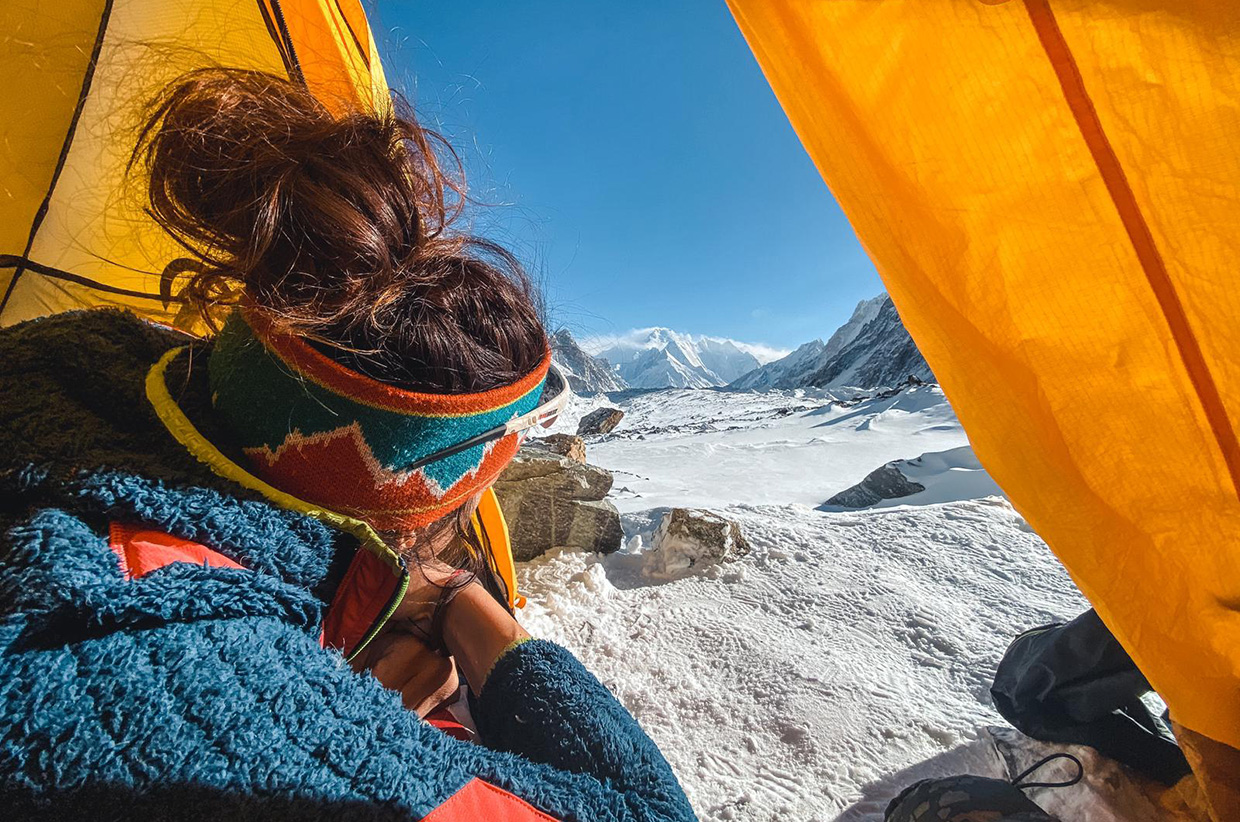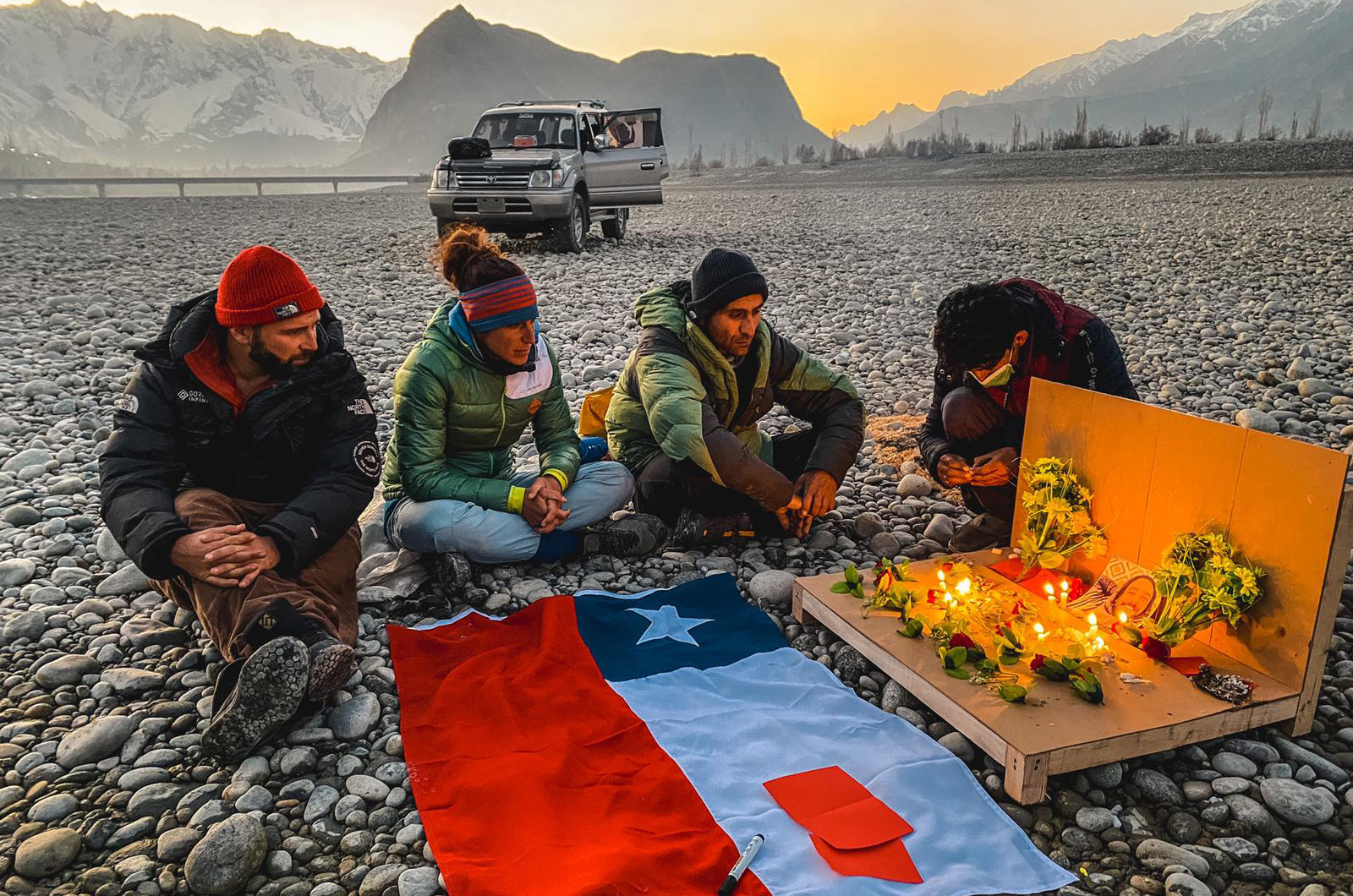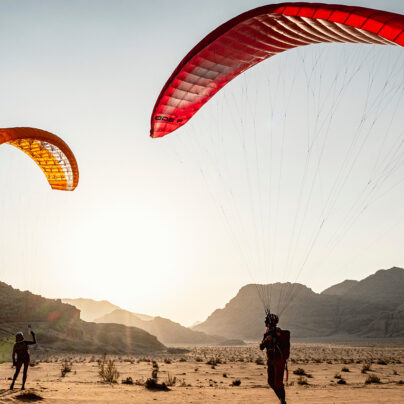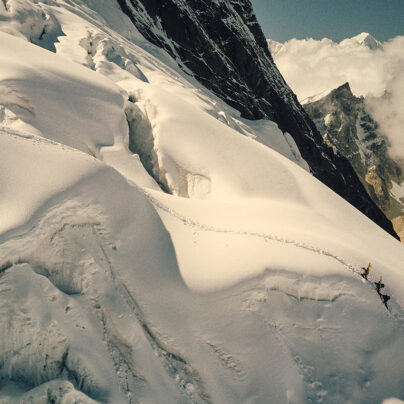The End Is My Beginning
Story & Photography: Tamara Lunger
Written By: Marta Manzoni
Oh my god, that’s a person! It’s a person!
I scream as I see something, someone, fall from the Abruzzi Spur in front of my eyes. They do somersaults, roll fast, too fast, from the infinite vertical wall. Their head goes up and down, up and down. They land 40m from me at Advanced Base Camp. Shock. My heart is racing. Breath broken, mind clouded. I’m not lucid. I think of everything in those few steps as I approach the body. Who is it? Will they be alive? In what condition will I find them?
The End is my Beginning
The journey to get here – especially the inner one – started during the first lockdown, in the spring of 2020, while I was practising yoga and mindfulness at home in Italy. Why do I want to climb K2 in winter? Do I just want to show everyone that I am a tough mountaineer? No, that’s not it. Is this what I really want? The desire must come from my heart. I meditated, reflected. And K2 continued to come looking for me, like a blade stuck in my mind. It wouldn’t leave me alone. Sometimes it made me cry. So what? So be it. As soon as I decided to leave, I finally found peace.
When I took off from Italy I was sure it would be a successful expedition. In 2014, when I had climbed K2 without oxygen, I had felt a great harmony with the mountain. This time, however, as soon as I set foot in Pakistan, things started to go wrong. I didn’t connect with my climbing partner, the Romanian Alex Gavan. He was suspicious; he felt in competition with me, even thought I wanted to teach him how to climb. Then, he would walk alone at night on the mountain, making me worry – if something happened to him then I should obviously go to help, putting my own life in danger. I had decided before leaving that I would only walk in the dark in a true emergency.
This was the most difficult expedition of my life. Attempting K2 in winter, the only 8,000er still unclimbed in the coldest season, is not like going to the post office. I knew that I needed all my energy; I couldn’t afford to waste it fighting with Alex. ‘From now on, our paths diverge,’ I told my former partner.
Up there, you can’t get it wrong.

The Nepali Flag Flies on K2
The 10 Nepali mountaineers who were with us on that expedition wrote history by reaching the summit of K2 in winter, forever cementing their status as world-class mountaineers – no longer would they be known as simple porters. It was the success of a people, and a very powerful message; they were really strong. I felt very proud of them. They deserved it. We toasted together: they had achieved an extraordinary feat, well coordinated and in harmony. This was how it should be. And it was thanks to them that the other climbers could try the summit, because they equipped the route with fixed ropes, without which it’s impossible to attempt K2 in winter.
Nirmal ‘Nims’ Purja, after this first memorable ascent, told me: ‘Tamara, be careful: this mountain does not forgive anything.’ And he gave me one of his lucky charms. A premonition. But this success was, in fact, accompanied by tragedy.
The Worst Day
I take the last steps and immediately see the unmistakable red jacket trimmed with fur. His blue sash. Even without being able to see his face, I understand immediately that it’s him. Spanish mountaineer Sergi Mingote is lying on his stomach, facing the mountain. He is still breathing but everything is broken, skull cracked, legs displaced from fractures. How did he fall?
Slowly other people arrive – first the Chilean Juan Pablo, Sergi’s climbing partner, who runs down the mountain like a missile. We don’t want to move him because if we do something wrong we risk killing him. Meanwhile, we try to contact rescue. We cover him up and try to talk to him. An interminable hour passes, and after another 15 minutes Sergi stops breathing. Two days before we had sung and danced together with Juan Pablo. They were always cheerful, positive; we had a lot of fun together. They made me feel at home. Sergi was like a father to me.
We turn him over and I look him in the face. I can’t even cry. I’m in shock.
‘It would have been hopeless even if the helicopter had been faster,’ the doctor says, later.
20 Days of Expedition Pass
It’s cold in the tent. It’s always so cold, but tonight it’s even more terrible: the cold penetrates my bones and doesn’t leave me alone for an instant. I’m afraid that my feet will freeze. I don’t want my fingers to be amputated.
As I go to Camp 3, I struggle to resist the urge to panic about how cold it will get. At Camp 1, which is at 6,000m, it’s already –45 degrees C inside the tent. I always sleep in two sleeping bags rated for –40 degrees while tucked into my high-altitude suit, and I’m still cold.
After the Nepali ascent, K2 seems to tell me and the other climbers that our place is not there. We are not welcome – the mountain does not want us. In the morning I prepare Sergi’s bag. Then they arrive to take him by helicopter. When I see him fly away I finally start to cry and, slowly, I let him go, even though I keep thinking about it all the time.



Alex Gavan gives up the climb and returns home, while I find a soulmate – a kind of guardian angel – in Juan Pablo (‘JP’). We have an incredible understanding: his sunny smile transmits a contagious energy, and we strengthen each other to overcome our grief. We need each other deeply. We’re always together; we laugh, talk a lot, cry. I know that I have to give myself some time to process what happened, and that it wouldn’t be a good idea to go home. I have to leave room for my emotions. My parents are really worried, and they keep asking me to come back. But I see a new enthusiasm arise, and I get involved with JP, who plans another attempt to the summit.
Before leaving Base Camp, however, I don’t feel my best. I have stomach issues, and my strength is weakened. My main goal of the expedition is to listen to the mountain, the messages it transmits to me. I want to be open to these emotions and I do, in fact, perceive a lot more than the other times. I weave together the different signals – especially the feelings that the mountain gives me – and so, having arrived at Camp 3, I decide not to try the summit. But it’s important for me to be there with JP just before he leaves. In the tent of Camp 3 I make myself small, staying in a corner so as not to disturb JP’s preparations, and then I see him leave in the dark. On February 5th I wait hours for news of him. Nothing. So, after leaving a stove and some food ready for him, I decide to descent. It’s simply unthinkable for me that he will not return; JP is a force to be reckoned with in the mountains.
As I descend from Camp 3, darkness comes and I get lost on the glacier alongside Irishman Noel Hanna. At one point I see a light behind me: surely it’s JP, I think. He’s really strong! I shout to the light. But it’s a sherpa, not him.
The tent is frozen, as always. I know that even tonight I won’t sleep a wink. My heart is full of melancholy. They tell me that JP and the other climbers did not return to the camp. Fuck. Two nights out in this temperature is really extreme. I’m torn. The fatigue from the physical effort of the climbs and the emotions of these weeks takes its toll. In winter there is ice everywhere out there – you always proceed standing on the tips of your crampons, and the physical effort that the body must support is truly remarkable. I slip into my sleeping bag and pray, sending positive energies to JP, Ali, and John, up there somewhere on their summit attempt. I’m convinced that the next day I will see them emerge from the mountain. But the next morning there’s no news. I pray with all my last hopes.
The next day everything is silent – again. Then I realise that it’s over. A shiver runs down my spine.

The Second-Worst Day
JP’s death breaks my heart. I cry all the time. I call my mom and dad, my best friend, and Simone Moro. I feel so weak. I haven’t even had the strength to change my underwear in days. I no longer have any physical or mental energy. Something has died inside of me too. Everyone at Base Camp is sad. I go to the kitchen with puffy eyes and the cooks try to comfort me; there is so much solidarity in trying to deal with this tragic moment.
JP’s family writes to me all the time, full of hopes of finding him again after nine days. All of Chile believes that JP is in some safe niche in the snow, alive. I understand that people who have not been up here don’t realise that at –60 degrees there’s a risk of freezing to death after just 10 minutes. I must be strong and gentle in telling the family that they have to say goodbye to JP.
After two months of expedition, it’s time to go home. I walk towards Skardu with the few people left. If life is a journey, then it is one that must be carried out on foot – this is the right speed to look at things. The trek to town is good for me. Step by step, I mentally digest what happened. It’s a kind of meditation. An intense journey. In Skardu I’m joined by JP’s cousin and his best friend, who have come to Pakistan to guarantee to his family that everything possible has been done and also tell them, little by little, that there is no longer any hope.
The three of us decide to say goodbye to JP in our own way. We print a photo of him smiling and buy some fake flowers (real ones are nowhere to be found). The idea is to put all these things on a raft with some candles and let it go along the river. We set the mood by putting on reggaeton, JP’s favourite music. Too bad that the Pakistani we had commissioned to build the raft builds a chair instead. So we have fake flowers, a chair instead of a raft, and candles going out every second. We can hardly cry for how absurd and funny the situation is – it’s hard to stay serious. We dance, thinking that if JP saw us with all this, he would have a big laugh. Maybe we really just need to smile. Speaking with the two of them, I understand that I really want to carry on JP’s social projects, helping to ensure that climbing and mountaineering arrive in places where the opportunity to experience them is missing. In July 2021 we will return to Pakistan for a project, and I especially want to work, alongside JP’s friends, for young girls to create a rock face to allow them to climb. From a tragedy something beautiful is born.
The mountain is everything: it can be the greatest joy in life, and half an hour later take it all away.
The mountain is also like a man: it has 1,000 different faces, from happiness to sadness to wickedness. Sometimes it wants you, sometimes it just doesn’t want you. Then, on some days an incredible fog arrives and seems to tell you get out of here! From this experience I believe that my trust in God will grow even greater. I would, of course, still like to laugh with JP, but I’m sure that he, along with Sergi and the others, is fine up there and one day we will all meet again, to play cards and climb other mountains. I feel so many emotions, and a lot of gratitude for having met extraordinary people, thanks to whom I have lived unique moments. I will carry them with me forever.
In addition to this story Tamara Lunger shares a powerful story from her recent expedition to the Gasherbrum peaks in Pakistan, and her candid reflections on successive expeditions to Pakistan’s 8000ers. Read ‘The Void’s Edge in Sidetracked Volume 21.





